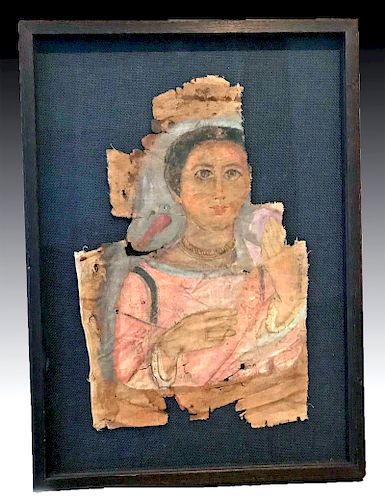Framed Egyptian Romano (Faiyum) Portrait on Linen
Lot 21f
About Seller
Artemis Gallery
686 S Taylor Ave, Ste 106
Louisville, CO 80027
United States
Selling antiquities, ancient and ethnographic art online since 1993, Artemis Gallery specializes in Classical Antiquities (Egyptian, Greek, Roman, Near Eastern), Asian, Pre-Columbian, African / Tribal / Oceanographic art. Our extensive inventory includes pottery, stone, metal, wood, glass and textil...Read more
Estimate:
$18,000 - $25,000
Absentee vs Live bid
Two ways to bid:
- Leave a max absentee bid and the platform will bid on your behalf up to your maximum bid during the live auction.
- Bid live during the auction and your bids will be submitted real-time to the auctioneer.
Bid Increments
| Price | Bid Increment |
|---|---|
| $0 | $25 |
| $300 | $50 |
| $1,000 | $100 |
| $2,000 | $250 |
| $5,000 | $500 |
| $10,000 | $1,000 |
| $20,000 | $2,500 |
| $50,000 | $5,000 |
| $100,000 | $10,000 |
| $200,000 | $20,000 |
About Auction
By Artemis Gallery
Sep 26, 2019
Set Reminder
2019-09-26 10:00:00
2019-09-26 10:00:00
America/New_York
Bidsquare
Bidsquare : Exceptional Day 1: Antiquities & Asian Art
https://www.bidsquare.com/auctions/artemis-gallery/exceptional-day-1-antiquities-asian-art-4437
Day 1 of an important 2-day auction featuring exceptional, museum-worthy examples of Egyptian, Greek, Etruscan, Roman, Viking, Russian, Near Eastern, as well as Asian Art from China, Japan, Thailand, Vietnam, Burma and India. Artemis Gallery info@artemisgallery.com
Day 1 of an important 2-day auction featuring exceptional, museum-worthy examples of Egyptian, Greek, Etruscan, Roman, Viking, Russian, Near Eastern, as well as Asian Art from China, Japan, Thailand, Vietnam, Burma and India. Artemis Gallery info@artemisgallery.com
- Lot Description
Egypt in the Roman Era, ca. 2nd to 3rd century CE. A very rare, life-like mummy portrait on linen, similar stylistically and iconographically to Faiyum portraits, depicting a beautiful, young, wealthy female wearing a refined long sleeve dress of breathtakingly vivid pastel pink hues with light and dark blue trim, and elaborately adorned with a double strand necklace and a gold ring placed upon her right ring finger. A bird of colorful red and blue plumes, most likely symbolizing the Egyptian god Horus who oftentimes appears in Egyptian funerary art, perches upon her shoulder, and she holds what was most likely a wreath of pink rose petals. Egyptian Romano portraits on linen are very rare, and this particular one is quite exceptional not only for its technique but also for the sitter\'s transfixing presence and the painting\'s paramount artistry. Beautifully set against a black fabric ground in a lovely wooden frame under glass. Size (portrait): 13.25" W x 20.75" H (33.7 cm x 52.7 cm); 19" W x 26.25" H (48.3 cm x 66.7 cm) including frame.
While most examples were made of encaustic (melted wax) paint on wood, this example was created via a much less common technique whereby the artist applied colored stucco or tempera paint to a linen shroud. While portraits painted on wooden panels were usually created while the subject was actually alive and put on display in the home, portraits on linen like this example were painted posthumously.
A quintessential Egyptian Romano portrait, skillfully composed to highlight the woman's direct frontal gaze and mesmerizing presence; the likeness certainly exemplifies the Greco-Roman painting style, but at the same time, its purpose, that is to present ancient person with captivating immediacy, was most definitely Egyptian in character. This piece represents a remarkable fusion of Egyptian practices with the Greco-Romano aesthetic. As you can see, the portrait depicts the deceased woman in the prime of her youth, dressed to impress, with elegant hair and jewelry that imitated the fashions of imperial Rome; however, the custom of mummification to accompany the deceased in the afterlife was most definitely Egyptian.
Provenance: private East Coast, USA collection; ex-California Museum of Ancient Art; ex-French private collection, bought in 1969 from Galerie Le Corneur Roudillon in ParisA section from a larger linen shroud. Some fading commensurate with age, but colors and lines are remarkably vivid. Set in a custom frame.Condition
- Shipping Info
-
All shipping is handled in-house for your convenience. Your invoice from Artemis Gallery will include shipping calculation instructions. If in doubt, please inquire BEFORE bidding for estimated shipping costs for individual items.
-
- Buyer's Premium



 EUR
EUR CAD
CAD AUD
AUD GBP
GBP MXN
MXN HKD
HKD CNY
CNY MYR
MYR SEK
SEK SGD
SGD CHF
CHF THB
THB





